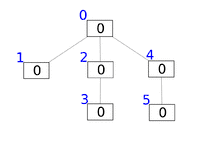Fenwick tree

A Fenwick tree or binary indexed tree is a data structure that can efficiently update elements and calculate prefix sums in a table of numbers. This structure was proposed by Peter Fenwick in 1994 to improve the efficiency of arithmetic coding compression algorithms.[1]
When compared with a flat array of numbers, the Fenwick tree achieves a much better balance between two operations: element update and prefix sum calculation. In a flat array of numbers, you can either store the elements, or the prefix sums. In the first case, computing prefix sums requires linear time; in the second case, updating the array elements requires linear time (in both cases, the other operation can be performed in constant time). Fenwick trees allow both operations to be performed in time. This is achieved by representing the numbers as a tree, where the value of each node is the sum of the numbers in that subtree. The tree structure allows operations to be performed using only node accesses.
Motivation
Given a table of elements, it is sometimes desirable to calculate the running total of values up to each index according to some associative binary operation (addition on integers being by far the most common). Fenwick trees provide a method to query the running total at any index, in addition to allowing changes to the underlying value table and having all further queries reflect those changes.
Fenwick trees are particularly designed to implement the arithmetic coding algorithm, which maintains counts of each symbol produced and needs to convert those to the cumulative probability of a symbol less than a given symbol. Development of operations it supports were primarily motivated by use in that case.
Using a Fenwick tree it requires only operations to compute any desired cumulative sum, or more generally the sum of any range of values (not necessarily starting at zero).
Fenwick trees can be extended to update and query subarrays of multidimensional arrays. These operations can be performed with complexity , where is number of dimensions and is the number of elements along each dimension.[2]
Description
Although Fenwick trees are trees in concept, in practice they are implemented as an implicit data structure using a flat array analogous to implementations of a binary heap. Given an index in the array representing a vertex, the index of a vertex's parent or child is calculated through bitwise operations on the binary representation of its index. Each element of the array contains the pre-calculated sum of a range of values, and by combining that sum with additional ranges encountered during an upward traversal to the root, the prefix sum is calculated. When a table value is modified, all range sums which contain the modified value are in turn modified during a similar traversal of the tree. The range sums are defined in such a way that both queries and modifications to the table are executed in asymptotically equivalent time ( in the worst case).
The initial process of building the Fenwick tree over a table of values runs in time. Other efficient operations include locating the index of a value if all values are positive, or all indices with a given value if all values are non-negative. Also supported is the scaling of all values by a constant factor in time.
A Fenwick tree is most easily understood by considering a one-based array. Each element whose index i is a power of 2 contains the sum of the first i elements. Elements whose indices are the sum of two (distinct) powers of 2 contain the sum of the elements since the preceding power of 2. In general, each element contains the sum of the values since its parent in the tree, and that parent is found by clearing the least-significant bit in the index.
To find the sum up to any given index, consider the binary expansion of the index, and add elements which correspond to each 1 bit in the binary form.
For example, say one wishes to find the sum of the first eleven values. Eleven is 10112 in binary. This contains three 1 bits, so three elements must be added: 10002, 10102, and 10112. These contain the sums of values 1–8, 9–10, and 11, respectively.
To modify the eleventh value, the elements which must be modified are 10112, 11002, 100002, and all higher powers of 2 up to the size of the array. These contain the sums of values 11, 9–12, and 1–16, respectively. The maximum number of elements which may need to be updated is limited by the number of bits in the size of the array.
Implementation
A simple C implementation follows.
#define LSB(i) ((i) & -(i)) // zeroes all the bits except the least significant one
int A[SIZE];
int sum(int i) // Returns the sum from index 1 to i
{
int sum = 0;
while (i > 0)
sum += A[i], i -= LSB(i);
return sum;
}
void add(int i, int k) // Adds k to element with index i
{
while (i < SIZE)
A[i] += k, i += LSB(i);
}
See also
References
- ↑ Peter M. Fenwick (1994). "A new data structure for cumulative frequency tables" (PDF). Software: Practice and Experience. 24 (3): 327–336. CiteSeerX 10.1.1.14.8917. doi:10.1002/spe.4380240306.
- ↑ Pushkar Mishra (2013). "A New Algorithm for Updating and Querying Sub-arrays of Multidimensional Arrays". arXiv:1311.6093 [cs.DS]. doi:10.13140/RG.2.1.2394.2485. Cite uses deprecated parameter
|class=(help)